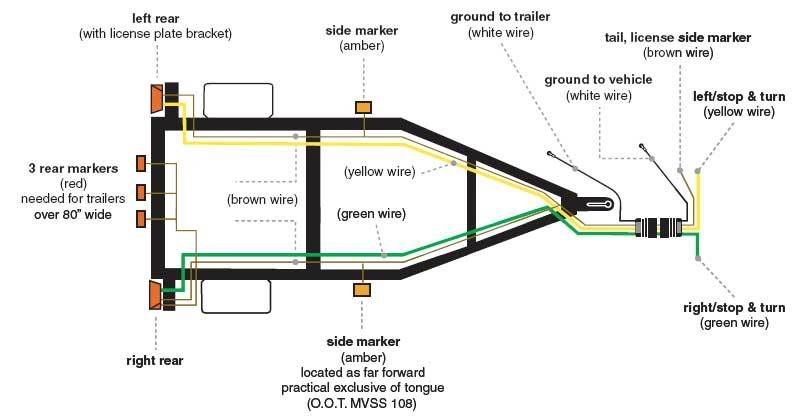I had a question about running lights, tail lights and such. I don’t have my hitch or the wiring yet but etrailer says I need this one.
What my question is..I had planned on having just two lights on the back that did braking and also did the blinking. Can I also have the running lights on each respective side blink with the back ones? How would this wiring go? Would I need something more than what etrailer says I need?
Thanks,
mandy
blinker/tail lights question
39 posts
• Page 1 of 3 • 1, 2, 3
I assume that your Jeep has separate stop and turn lights, which is why the adapter/converter is needed (and why there are five wires into the converter, and four out).
The side markers can't be hooked up directly to the combined stop/turn on the same side, because then they would go on with brake application. Actually, some people have done this, but that doesn't make it right.
The four-wire output of the converter doesn't have a turn-only signal in it, which leaves two choices that I can think of: more connections between tug and trailer, for some interesting circuit logic.
The problem with more connections (aside from actually doing the wiring) is that you need too many pins on the connector. Instead of the three lighting signals (left, right, tail) of the 4-pin connection, or the four lighting connections of a separate system (left, right, stop, tail), you actually need five: left turn, left stop/turn, right turn, right stop/turn, and tail. Even if you use the common 7-pin connector and use the auxilliary pin for one function, you're still one short. The easiest method would probably be to run an extra four-pin connector (with one unused pin).
Rebuilding the separated turn signals with circuitry on the trailer isn't easy, either. You could use a readily available logic circuit to make a stop-only signal out of the two stop/turns (they're made to run high-level centre-mounted stop lamps), then use it and the stop/turn signal in a relay configuration to run the side markers.
Either scheme seems like a hassle to me. I would rather just do the whole trailer with separate stop and turn lamps, including the main lamps on the back. Then a simple isolator would be used instead of the converter in the T-One setup (you still need the wiring harness to intercept the Jeep's wiring), and some connector with enough pins (I would use a 7-pin) to get all five wires (ground, left, right, stop, tail) to the trailer.
With any scheme for blinking marker lights, the lamps need either two levels of brightness (two bulbs or a double-filament bulb), or to be driven by something like a relay which interrupts the marker (tail) power to cause the flashing. The dual-intensity system gives a much clearer signal to other drivers, which I assume is the whole point.
The side markers can't be hooked up directly to the combined stop/turn on the same side, because then they would go on with brake application. Actually, some people have done this, but that doesn't make it right.
The four-wire output of the converter doesn't have a turn-only signal in it, which leaves two choices that I can think of: more connections between tug and trailer, for some interesting circuit logic.
The problem with more connections (aside from actually doing the wiring) is that you need too many pins on the connector. Instead of the three lighting signals (left, right, tail) of the 4-pin connection, or the four lighting connections of a separate system (left, right, stop, tail), you actually need five: left turn, left stop/turn, right turn, right stop/turn, and tail. Even if you use the common 7-pin connector and use the auxilliary pin for one function, you're still one short. The easiest method would probably be to run an extra four-pin connector (with one unused pin).
Rebuilding the separated turn signals with circuitry on the trailer isn't easy, either. You could use a readily available logic circuit to make a stop-only signal out of the two stop/turns (they're made to run high-level centre-mounted stop lamps), then use it and the stop/turn signal in a relay configuration to run the side markers.
Either scheme seems like a hassle to me. I would rather just do the whole trailer with separate stop and turn lamps, including the main lamps on the back. Then a simple isolator would be used instead of the converter in the T-One setup (you still need the wiring harness to intercept the Jeep's wiring), and some connector with enough pins (I would use a 7-pin) to get all five wires (ground, left, right, stop, tail) to the trailer.
With any scheme for blinking marker lights, the lamps need either two levels of brightness (two bulbs or a double-filament bulb), or to be driven by something like a relay which interrupts the marker (tail) power to cause the flashing. The dual-intensity system gives a much clearer signal to other drivers, which I assume is the whole point.
- brian_bp
- 1000 Club

- Posts: 1355
- Images: 9
- Joined: Sun Nov 19, 2006 1:25 pm
- Location: Alberta

 my original plan was actually just to do what i believe you described. have a brake and a turn signal light seperate on the back for each side. so you say i will need some sort of "isolator" to make this work?
my original plan was actually just to do what i believe you described. have a brake and a turn signal light seperate on the back for each side. so you say i will need some sort of "isolator" to make this work?



